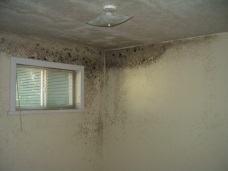Dangers of Mold in Your Home or Business
What You Need to Know About Mold
Mold spores are everywhere. It is an essential part of nature. Molds help break down wood, leaves, grass and other dead plant material. Every time we enter a building from outside, we bring in mold spores – on our clothes, on our shoes, and in the air. Normally, these spores in the air and our environment do not affect us. 
However, when water or high humidity (>60%) is introduced into our closed living quarters and porous materials that support mold growth (such as drywall, wood, carpeting) get wet, the spores will often start growing.
When these conditions are present, the concentration of spores in the air becomes very high relative to the outside. Many individuals become sensitized to these high levels and start experiencing health effects.
Health Effects
Health effects can range anywhere from headaches, fatigue, coughs, respiratory problems similar to a cold or the flu, or even bloody noses can be associated with mold growth. In some individuals, this exposure to mold spores suppresses their immune system and other health problems result.
Problematic Molds
Not all molds have the same effect on humans. There are a few that have a more toxic effect than others. The more commonly encountered molds in this category are Stachybotrys, and Aspergillus/Penicillium.
Mold Toxins
Molds, like any organism, are very competitive to ensure their survival. One mechanism that they use is the production of toxins, called mycotoxins, that kill bacteria and other mold types. These mycotoxins can affect humans and cause allergic reactions, sometimes very severe. Mycotoxins exist in the shell of the spore. This means that even dead spores in dust and in the air can still cause problems in humans.
Mold Remediation
When there is mold growth in a building, it is not enough to just kill the mold with biocides. It must be physically removed. This includes removing spores (which are “sticky”) from all hard surfaces such as walls, ceilings, floors, furniture and building fixtures.
Porous materials, such as carpeting, curtains, furniture, paper, and clothing need to be cleaned and/or vacuumed using a vacuum cleaner with a special HEPA filter. Normal vacuum cleaners without a HEPA filter will just re-suspend the tiny mold spores in the air. A certified mold remediator is important.
Air Purifiers and Mold Spores
Another way to remove mold spores from a living space is through air purifiers with HEPA filters. It should be noted that air machines using ozone to kill mold spores are not recommended by the EPA because of ozone’s effect on personal health and also on the degradation of plastic materials.


